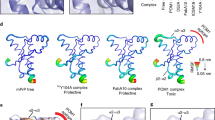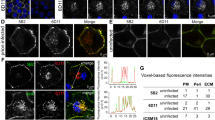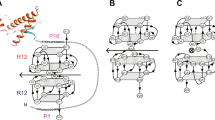Abstract
Conformational conversion of proteins in disease is likely to be accompanied by molecular surface exposure of previously sequestered amino-acid side chains. We found that induction of β-sheet structures in recombinant prion proteins is associated with increased solvent accessibility of tyrosine. Antibodies directed against the prion protein repeat motif, tyrosine-tyrosine-arginine, recognize the pathological isoform of the prion protein but not the normal cellular isoform, as assessed by immunoprecipitation, plate capture immunoassay and flow cytometry. Antibody binding to the pathological epitope is saturable and specific, and can be created in vitro by partial denaturation of normal brain prion protein. Conformation-selective exposure of Tyr-Tyr-Arg provides a probe for the distribution and structure of pathologically misfolded prion protein, and may lead to new diagnostics and therapeutics for prion diseases.
This is a preview of subscription content, access via your institution
Access options
Subscribe to this journal
Receive 12 print issues and online access
$209.00 per year
only $17.42 per issue
Buy this article
- Purchase on Springer Link
- Instant access to full article PDF
Prices may be subject to local taxes which are calculated during checkout




Similar content being viewed by others
References
Prusiner, S.B. Prions. Proc. Natl. Acad. Sci. USA 95, 13363–13383 (1998).
Will, R.G. et al. A new variant of Creutzfeldt-Jakob disease in the UK. Lancet 347, 921–925 (1996).
Coulthart, M.B. & Cashman, N.R. Variant Creutzfeldt-Jakob disease: a summary of current scientific knowledge in relation to public health. Can. Med. Assoc. J. 165, 51–58 (2001).
Bolton, D.C., McKinley M.P. & Prusiner S.B. Identification of a protein that purifies with the scrapie prion. Science 218, 1309–1311 (1982).
Pan, K.-M. et al. Conversion of alpha-helices into beta-sheets features in the formation of the scrapie prion proteins. Proc. Natl. Acad. Sci. USA 90, 10962–10966 (1993).
Pergami, P., Jaffe, H. & Safar, J. Semipreparative chromatographic method to purify the normal cellular isoform of the prion protein in nondenatured form. Anal. Biochem. 236, 63–73 (1996).
Korth, C. et al. Prion (PrPSc)-specific epitope defined by a monoclonal antibody. Nature 390, 74–77 (1997).
Fischer, M.B., Roeckl, C., Parizek, P., Schwarz, H.P. & Aguzzi, A. Binding of disease-associated prion protein to plasminogen. Nature 408, 479–483 (2000).
Heppner, F.L. et al. Prevention of scrapie pathogenesis by transgenic expression of anti-prion protein antibodies. Science 294, 178–182 (2001).
Swietnicki, W., Petersen, R., Gambetti, P. & Surewicz, W.K. pH-dependent stability and conformation of the recombinant human prion protein PrP(90-231). J. Biol. Chem. 272, 27517–27520 (1997).
Hornemann, S. & Glockshuber, R. A scrapie-like unfolding intermediate of the prion protein domain PrP(121-231) induced by acidic pH. Proc. Natl. Acad. Sci. USA 95, 6010–6014 (1998).
Jackson, G.S. et al. Reversible conversion of monomeric human prion protein between native and fibrillogenic conformations. Science 283, 1935–1937 (1999).
Cioni, P. Oxygen and acrylamide quenching of protein phosphorescence: correlation with protein dynamics. Biophys. Chem. 87, 15–24 (2000).
Riek, R. et al. NMR structure of the mouse prion protein domain PrP(121-321). Nature 382, 180–182 (1996).
Liu, H. et al. Solution structure of Syrian hamster prion protein recombinant PrP(90-231). Biochemistry 38, 5362–5377 (1999).
Zahn, R. et al. NMR solution structure of the human prion protein. Proc. Natl. Acad. Sci. USA 97, 145–150 (2000).
Tang, L., Sampson, C., Dreitz, M.J. & McCall, C. Cloning and characterization of cDNAs encoding four different canine immunoglobulin gamma chains. Vet. Immunol. Immunopathol. 80, 259–270 (2001).
Sela, M., Mozes, E., Zisman, E., Muszkat, K.A. & Schechter, B. A tale of two peptides, TyrTyrGluGlu and TyrGluTyrGlu, and their diverse immune behaviour. Behring Inst. Mitt. 91, 54–66 (1992).
Zou, W-Q. & Cashman N.R. Acidic pH and detergents enhance in vitro conversion of human brain PrPC to a PrPSc-like form. J. Biol. Chem. 277, 43942–43947 (2002).
Rubenstein, R. et al. Scrapie-infected spleens: analysis of infectivity, scrapie-associated fibrils, and protease-resistant proteins. J. Infect. Dis. 164, 29–35 (1991).
Race, R.E. & Ernst, D. Detection of proteinase K-resistant prion protein and infectivity in mouse spleen by 2 weeks after scrapie agent inoculation. J. Gen. Virol. 73, 3319–3323 (1992).
Tatzelt, J., Groth, D.F., Torchia, M., Prusiner, S.B. & DeArmond, S.J. Kinetics of prion protein accumulation in the CNS of mice with experimental scrapie. J. Neuropathol. Exp. Neurol. 58, 1244–1249 (1999).
Lezmi, S., Bencsik, A. & Baron, T. CNA42 monoclonal antibody identifies FDC as PrPsc accumulating cells in the spleen of scrapie affected sheep. Vet. Immunol. Immunopathol. 82, 1–8 (2001).
Hill, A.F. et al. Investigation of variant Creutzfeldt-Jakob disease and other human prion diseases with tonsil biopsy samples. Lancet 353, 183–189 (1999).
Mabbot, N.A. & Bruce M.E. The immunobiology of TSE diseases. J. Gen. Virol. 82, 2307–2318 (2001).
Safar, J.G. et al. Measuring prions causing bovine spongiform encephalopathy or chronic wasting disease by immunoassays and transgenic mice. Nat. Biotechnol. 20, 1147–1150 (2002).
Safar, J.G. et al. Eight prion strains have PrP(Sc) molecules with different conformations. Nat. Med. 4, 1157–1165 (1998).
Hill A.F. et al. Species-barrier-independent prion replication in apparently resistant species. Proc. Natl. Acad. Sci. USA 97 10248–10253 (2000).
Horiuchi M., Priola S.A., Chabry J. & Caughey B. Interactions between heterologous forms of prion protein:binding, inhibition of conversion, and species barriers. Proc. Natl Acad. Sci. USA 97, 5836–5841 (2000).
Aguzzi A. & Weissmann C. Prion research: the next frontiers. Nature 389, 795–798 (1997).
Szakal, A.K. & Tew, J.G. Follicular dendritic cells: B-cell proliferation and maturation. Cancer Res. 52, 5554s–5556s (1992).
Klein, M.A. et al. Complement facilitates early prion pathogenesis. Nat. Med. 7, 488–492 (2001).
Mabbott, N.A. et al. Temporary depletion of complement component C3 or genetic deficiency of C1q significantly delays onset of scrapie. Nat. Med. 7, 485–487 (2001).
Klein, M.A. et al. A crucial role for B cells in neuroinvasive scrapie. Nature 390, 687–690 (1997).
Gajdusek, D.C. Unconventional viruses causing subacute spongiform encephalopathies. in Virology (ed. Fields, B.N.) 1516–1557 (Raven Press, New York, 1986).
Enari, M., Flechsig, E. & Weissmann, C. Scrapie prion protein accumulation by scrapie-infected neuroblastoma cells abrogated by exposure to a prion protein antibody. Proc. Natl. Acad. Sci. USA 98, 9295–9299 (2001).
Peretz, D. et al. Antibodies inhibit prion propagation and clear cell cultures of prion infectivity. Nature 412, 739–743 (2001).
Mouillet-Richard, S. et al. Signal transduction through prion protein. Science 289, 1925–1928 (2000).
Cashman, N.R. et al. Cellular isoform of the scrapie agent protein participates in lymphocyte activation. Cell 61, 185–192 (1990).
Bendheim, P.E. et al. Nearly ubiquitous tissue distribution of the scrapie agent precursor protein. Neurology 42, 149–156 (1992).
White, A.R. et al. Monoclonal antibodies inhibit prion replication and delay the development of prion disease. Nature 422, 80–83 (2003).
Wille, H. et al. Structural studies of the scrapie prion protein by electron crystallography. Proc. Natl. Acad. Sci. USA 99, 3563–3568 (2002).
Peretz, D. et al. A conformational transition at the N terminus of the prion protein features in formation of the scrapie isoform. J. Mol. Biol. 273, 614–622 (1997).
Safar, J., Roller, P.P., Gajdusek, D.C. & Gibbs, C.J. Jr. Scrapie amyloid (prion) protein has the conformational characteristics of an aggregated molten globule folding intermediate. Biochemistry 33, 8375–8383 (1994).
Szakal, A.K., Gieringer, R.L., Kosco, M.H & Tew J.G. Isolated follicular dendritic cells: cytochemical antigen localization, Nomarski, SEM, and TEM morphology. J. Immunol. 134, 1349–1359 (1985).
Acknowledgements
We thank A. Aguzzi, C. Bergeron, R. Jackman, R. Carp, B. Oesch, R. Rohwer, R. Rubinstein and M. J. Schmerr for provision of infected material and facilities; K. Qin and D. Westaway for recombinant mouse PrP; B. Bartol, P. Cunningham, P. Cecchetti, B. O'Brien-Graf, C. Quan and E. Thibaudeau for expert technical assistance; D. Chelsky and J. Griffin for critical reading of the manuscript; and C. Desjardins and L. Segal for their encouragement and support of this work. N.R.C. is the Jeno and Ilona Diener Chair of Neurodegenerative Diseases at the University of Toronto and Sunnybrook & Women's College Health Sciences Center, and is a Founder and Scientific Advisor of Caprion Pharmaceuticals. This work was supported by Caprion Pharmaceuticals, the Canadian Institutes of Health Research (Institute of Infection and Immunity) and McDonald's Corporation.
Author information
Authors and Affiliations
Corresponding author
Ethics declarations
Competing interests
The manuscript represents university-industry collaboration between scientists at the University of Toronto and two biotechnology companies (Caprion Pharmaceuticals of Montreal, Canada and Idexx Laboratories of Portland, Maine). N.R.C. is a professor at the University of Toronto, as well as founder and scientific advisor of Caprion Pharmaceuticals, from which he has derived partial salary and laboratory operating grants. The commercial aspects of this discovery are being developed under license from Caprion to Idexx and Ortho Clinical Diagnostics.
Supplementary information
Rights and permissions
About this article
Cite this article
Paramithiotis, E., Pinard, M., Lawton, T. et al. A prion protein epitope selective for the pathologically misfolded conformation. Nat Med 9, 893–899 (2003). https://doi.org/10.1038/nm883
Received:
Accepted:
Published:
Issue Date:
DOI: https://doi.org/10.1038/nm883
This article is cited by
-
Vaccines for prion diseases: a realistic goal?
Cell and Tissue Research (2023)
-
Substoichiometric inhibition of transthyretin misfolding by immune-targeting sparsely populated misfolding intermediates: a potential diagnostic and therapeutic for TTR amyloidoses
Scientific Reports (2016)
-
Nε-Carboxymethyl Modification of Lysine Residues in Pathogenic Prion Isoforms
Molecular Neurobiology (2016)
-
Recombinant Single-Chain Antibody with the Trojan Peptide Penetratin Positioned in the Linker Region Enables Cargo Transfer Across the Blood–Brain Barrier
Applied Biochemistry and Biotechnology (2013)
-
Tracking a toxic polyQ epitope
Nature Chemical Biology (2011)



